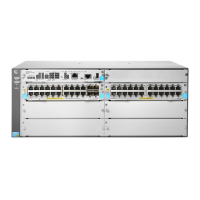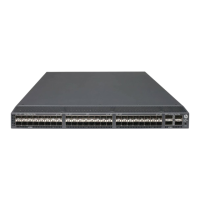48
Link down alarm mechanism
In an RRPP domain, when the transit node, edge node, or assistant edge node finds that any of its
ports is down, it immediately sends Link-Down packets to the master node. When the master node
receives a Link-Down packet, it takes the following actions:
• Releases the secondary port from blocking data VLANs.
• Sends Common-Flush-FDB packets to instruct all the transit nodes, edge nodes, and assistant
edge nodes to update their MAC address entries and ARP/ND entries.
After each node updates its own entries, traffic is switched to the normal link.
Ring recovery
When the ports in an RRPP domain on the transit nodes, edge nodes, or assistant edge nodes come
up again, the ring is recovered. However, the master node might detect the ring recovery after a
period of time. A temporary loop might arise in the data VLAN during this period. As a result, a
broadcast storm occurs.
To prevent such cases, non-master nodes block the ports immediately when they find the ports
accessing the ring are brought up again. The nodes block only the packets from the protected VLAN,
and they permit only the packets from the control VLAN to pass through. The blocked ports are
activated only when the nodes determine that no loop will be generated by these ports.
Broadcast storm suppression mechanism in case of SRPT failure in a multi-homed subring
As shown in Figure 16, Ring 1 is the primary ring, and Ring 2 and Ring 3 are subrings. When the two
SRPTs between the edge node and the assistant edge node are down, the master nodes of Ring 2
and Ring 3 will open their secondary ports. A loop is generated among Device B, Device C, Device E,
and Device F, causing a broadcast storm.
To avoid generating a loop, the edge node will temporarily block the edge port. The blocked edge
port is activated only when the edge node determines that no loop will be generated when the edge
port is activated.
RRPP ring group
In an edge node RRPP ring group, only the activated subring with the smallest domain ID and ring ID
can send Edge-Hello packets. In an assistant edge node RRPP ring group, any activated subring
that has received Edge-Hello packets will forward these packets to the other activated subrings.
When an edge node RRPP ring group and an assistant edge node RRPP ring group are configured,
the CPU workload is reduced because of the following reasons:
• Only one subring sends Edge-Hello packets on the edge node.
• Only one subring receives Edge-Hello packets on the assistant edge node.
As shown in Figure 16, De
vice B is the edge node of Ring 2 and Ring 3. Device C is the assistant
edge node of Ring 2 and Ring 3. Device B and Device C need to send or receive Edge-Hello packets
frequently. If more subrings are configured or more domains are configured for load balancing,
Device B and Device C will send or receive a large number of Edge-Hello packets.
To reduce Edge-Hello traffic, perform the following tasks:
• Assign Ring 2 and Ring 3 to an RRPP ring group configured on the edge node Device B.
• Assign Ring 2 and Ring 3 to an RRPP ring group configured on the assistant edge node Device
C.
If all rings are activated, only Ring 2 on Device B sends Edge-Hello packets.
Typical RRPP networking
Single ring
As shown in Figure 13, only a single ring exists in the network topology. You need only define an
RRPP domain.

